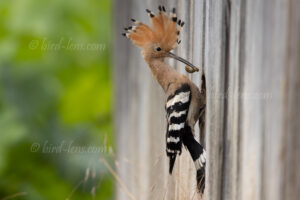 In undulating, butterfly-like flight, a bird with broad, deeply fingered wings comes flying onto an old shed. It is a hoopoe (Upupa epops) that takes a large insect, it looks like a mole cricket (Gryllotalpa gryllotalpa) to feed the young. On the second approach, the long, curved beak and the approximately 5 cm long, erectable crest are noticeable, the ends of which are also white-black. The rest of the body looks rusty brown.
In undulating, butterfly-like flight, a bird with broad, deeply fingered wings comes flying onto an old shed. It is a hoopoe (Upupa epops) that takes a large insect, it looks like a mole cricket (Gryllotalpa gryllotalpa) to feed the young. On the second approach, the long, curved beak and the approximately 5 cm long, erectable crest are noticeable, the ends of which are also white-black. The rest of the body looks rusty brown.
My friend shows me his garden with the Hoopoe boxes. Our observations are made at two nesting boxes, which have been installed in an open shelter or shed as part of a species protection and research program. The two nesting boxes are just 50 cm apart on two different sides.
The construction is remarkably simple. A box approx. 30 X 20 X 20 cm. There is also an exit that leads to a hole in the wall of the shed. All this at a height of just 50 cm from the ground.
When checking the nest box, we discovered 3 young Eurasian Hoopoes in a nest box. The smell wasn’t cardboard. First I thought of food and droppings spoiled by the sun. Then the phrase “You stink like a Hoopoe” came to mind. This statement is common in southern Germany and Switzerland. It comes from the fact that young birds drive away their enemies with a strong-smelling secretion. If they are attacked by a nest robber, the young are not defenseless. When attacked, they hiss angrily or squirt feces. In addition, like their mother, they give off a stinking secretion as a matter of habit and especially when there is danger. This odor is very unpleasant for both human and animal noses.
Just half an hour after I had waited out of the car about 25 meters from the shelter, a Eurasian Hoopoe suddenly clung to the lower entrance to the nest. As with other nestling flights, the Eurasian Hoopoe mainly brings caterpillars and large insects such as the mole cricket. It doesn’t take long before both partners (as far as I can judge) arrive practically every 5 minutes. Then, as the sky thickens and thick clouds and finally rain fall, the activity decreases, the feeding frequency almost to zero. Perhaps the caterpillars and insects are not as active and are more difficult to find. Or maybe the birds just want to keep their feathers dry.
What is striking is that the bird sometimes flies silently, sometimes it hisses as it approaches, which really gets the young in the box going. Then – and only then – can they be heard in the way one is used to from young woodpeckers in their nest. Otherwise, the young remain as quiet as a mouse.
In spring, the Eurasian Hoopoe pairs come together to breed together. The male Eurasian Hoopoe tries to win over a female with eager, typical calls. The calls of the male, which sound like “uup-uup” or “upupup” are very typical. Once it has gotten its attention, it convinces it with gifts of food and croaks to point out possible nesting holes. This can be a hole in an old fruit tree, a former woodpecker hole, a protected wall niche or a hidden hole in the ground.
This bird is distinctive. There is no species in our latitudes that resembles it. When the Eurasian Hoopoe returns from its wintering grounds in March/April, the chances of sightings are best in eastern Germany and the southwest, especially in the Kaiserstuhl area in the south-western corner of Germany. The contrasting black and white banded wings, the long, curved beak and the erect feather crest, the ends of which end in white and black, are striking. The tail is black with a broad white band and white markings at the base of the tail. The rest of the body is chestnut brown. Also characteristic is the wavy, butterfly-like flight, in which the wide, deeply fingered wings are almost flattened after each beat. Several long, continuous wing beats are followed by a few short, fluttering ones, so that the flight appears strangely unstable. The gallery shows a selection of the best pictures under the programmatic title Hoopoes at Kaiserstuhl.
To meet the growing demand for top-of-the-line images of the rarer Palaearctic species, Bird-lens.com strives to expand the range of images of Western Palaearctic birds. Trips to remote locations to take pictures of rare western Palearctic birds have been very successful. This beautiful picture of the blog was been made in a familiar site but is just a first impression of what you can find in the gallery in the “Picture Shop” very soon. Please leave a message if bird-lens.com can provide a picture.